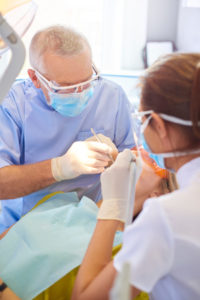 Kaiser Permanente’s integrated medical-dental clinic is part of a larger trend changing the way doctors and dentists deliver care
Kaiser Permanente’s integrated medical-dental clinic is part of a larger trend changing the way doctors and dentists deliver care
Primary care physicians are part of a growing movement to integrate medical and dental care. Some insurers, including Medicaid, recently began reimbursing physicians for applying fluoride varnish to pediatric patients under six years of age.
In January 2017, Oakland, Calif.-based Kaiser Permanente took medical-dental integration one step further, when it opened a pilot integrated medical-dental clinic in Beaverton, Ore. The clinic, Cedar Hills Dental and Medical Office, makes Kaiser Permanente’s Northwest division “the first commercial health care organization to integrate [medical and dental] health records as well as offer coordinated services,” says Kenneth R. Wright, DMD, MPH, vice president of dental services for Kaiser Foundation Health Plan of the Northwest.
Maximized convenience
Kaiser’s new clinic “is an innovation site where we will pilot new ways to combine dental and medical care that maximize convenience for our members and ensure their visits address their total health,” says Wright.
Before dental patients arrive for appointments, he says, “we look ahead to see whether they’re due for any medical procedures (like immunizations or blood pressure checks) that can be taken care of during their visit, sometimes right in the dental chair.” By using the integrated medical and dental electronic health records, dentists can notify the patient’s primary care physician directly regarding the patient’s needs.
Wright also notes that the new facility has a telemedicine room, “where patients can consult physicians at other Kaiser Permanente locations.”
The clinic’s staff consists of three general dentists, one pediatric dentist, seven dental assistants, one family practice physician, one physician assistant, and two nurse practitioners. Wright says that daily huddles between medical and dental staff will allow for communication between the two specialties, as will monthly meetings “to discuss innovative ways to integrate care for our members.”
The challenges of integrated care
Two of the biggest challenges in integrating medical and dental care are reimbursement and insurance, Sheila Brear, BDS, associate dean for academic affairs at the University of California, San Francisco School of Dentistry, told DrBicuspid.com in a January article. For example, some patients might only be covered for one service, medical or dental.
Wright acknowledges that integrating medical and dental insurance would allow more patients to receive integrated treatment, but “it is certainly not imperative for its success,” he says.
As for integration of electronic medical records – another challenge noted by Brear – Wright says that significant staff training and change management will be required to maintain a seamless care experience for patients.
Challenges aside, he believes that medical-dental integration is a way to enhance a person’s total health. “It is becoming increasingly recognized as the new standard of care delivery that results in superior and synergistic teamwork, leads to better collaboration with medical specialists for treatment of complex medical conditions, and is a better way to promote wellness and manage costs.”
Diabetes screening in the dentist’s office
A dental office might be the place for diabetes screening, according to a study published in BMJ Open Diabetes Research and Care.
Building on previous research that indicates an association between diabetes and oral diseases, the study, led by Wijnand J. Teeuw, DDS, M.Sc., examined 313 patients at the Academic Centre for Dentistry Amsterdam.
Researchers administered finger-stick blood tests to the patients – including 78 patients with severe periodontitis, 126 with mild/moderate periodontitis, and 109 controls – to gather their blood sugar levels. The results showed a significant overrepresentation of subjects with suspected diabetes and pre-diabetes in the severe periodontitis group and mild/moderate periodontitis group compared with the control group.
Researchers concluded that the “dental office, with particular focus on patients with severe periodontitis, proved to be a suitable location for screening for (pre)diabetes.” They also noted that a considerable number of suspected new diabetes cases were identified, particularly in those subjects with severe periodontitis.
Additionally, they said, the “early diagnosis and treatment of (pre)diabetes help to prevent more severe complications and benefit the treatment of periodontitis.”
Find the full BMJ study here: http://press.psprings.co.uk/drc/february/drc000326.pdf.
